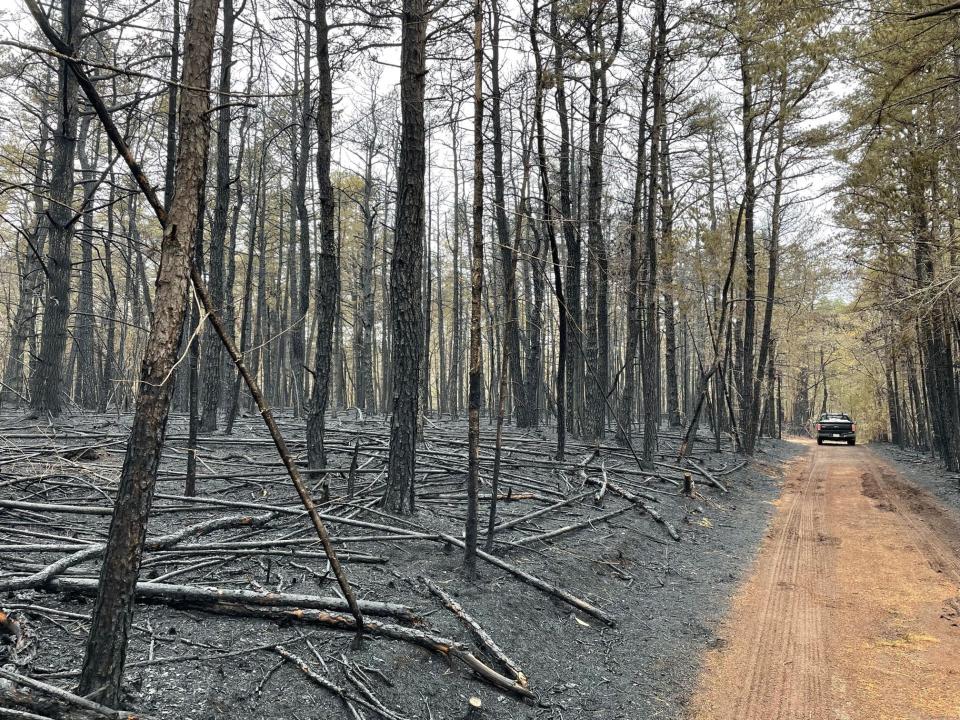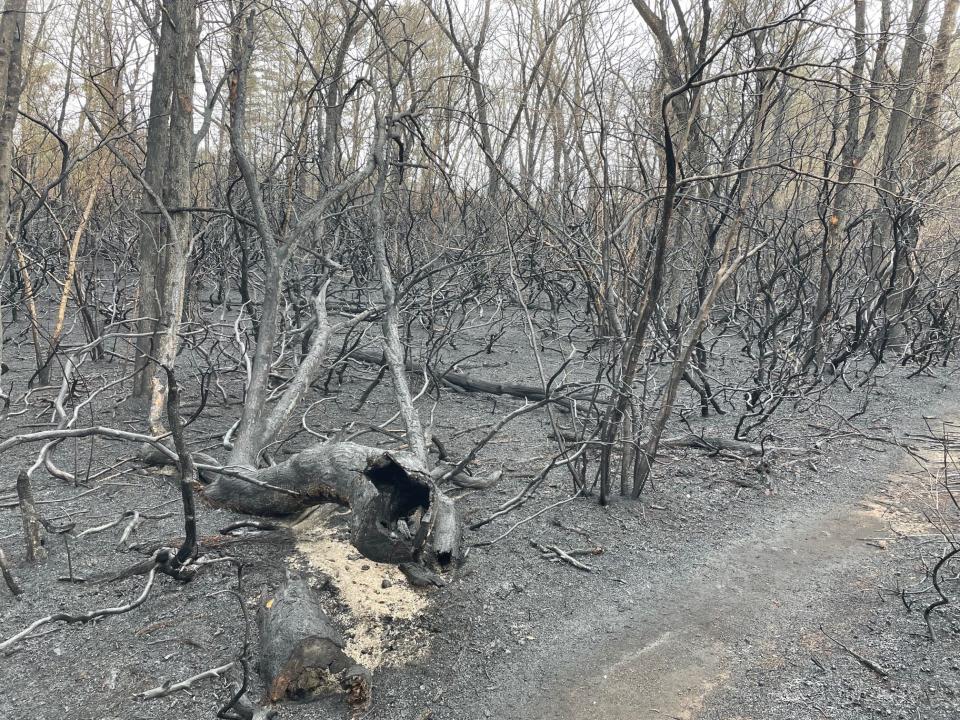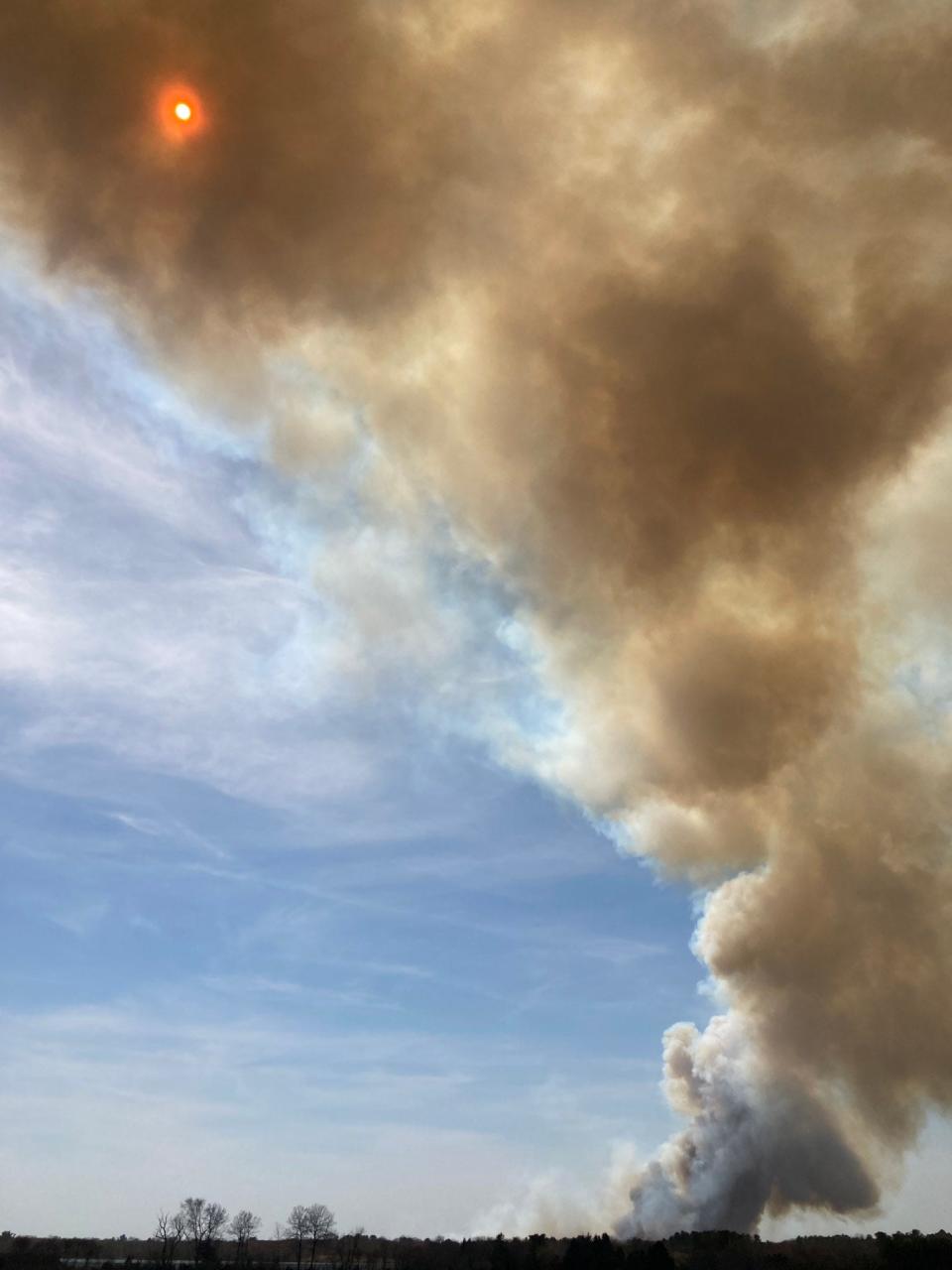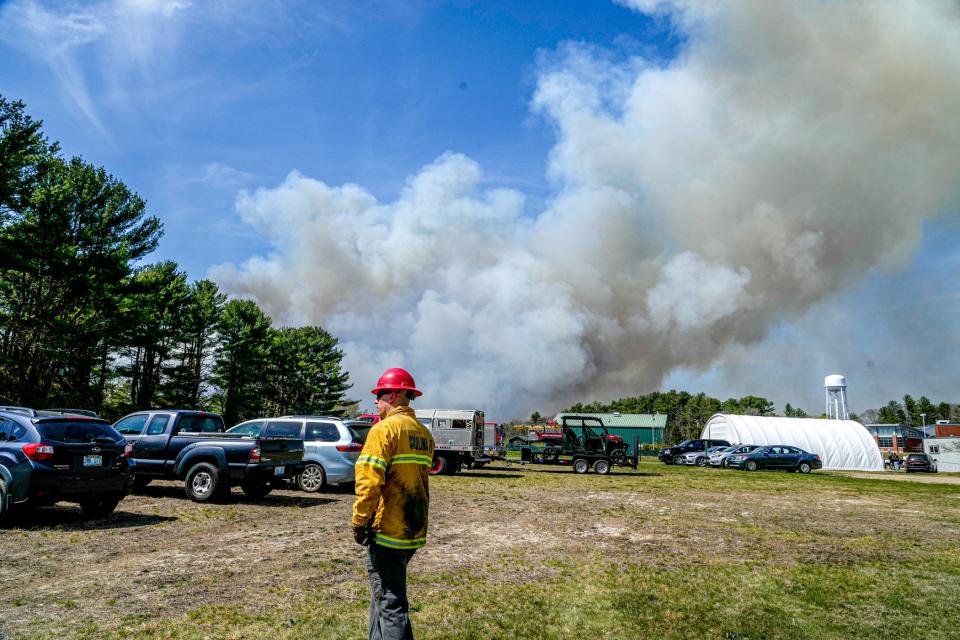Wildfires in Exeter last spring took Rhode Islanders by surprise. Are we ready for more?
EXETER – The fire sounded like a freight train as it barreled through hundreds of acres of forest in Queen's River Preserve on April 14, Scott Kettelle recalled. Flames raced up to the treetops, reaching 50 to 60 feet in the air.
"We will face that again," Kettelle, president of the Rhode Island Association of Fire Chiefs, told fellow members of a special legislative commission on preventing forest fires. "It’s just a matter of when."
For decades, Rhode Islanders could be forgiven for thinking wildfires were the kind of thing that happened out West – not something to worry about here. But that all changed in April, when Exeter witnessed the largest wildfire to scorch the state since 1942 – just a day after another brush fire had charred 200 acres in West Greenwich.
Uncontrolled wildfires could become more common as climate change leads to hotter, drier conditions in already-stressed forests. And some rural fire chiefs worry that Rhode Island isn't ready. Disease and insect infestations have left forests full of highly flammable tinder, access roads have been neglected and blocked, and the declining number of forest rangers and volunteer firefighters means there are fewer people to spot fires and put them out.
"Inaction is not an option," said Rep. Megan Cotter, D-Exeter, who sponsored the legislation that established the study commission and serves as its chair. "That’s how I view it."

Does forest management mean more logging?
Officially, the commission that Cotter chairs is known as the Special Legislative Commission to Evaluate and Provide Recommendations on Proper Forest Management for Fire Prevention.
The name raises an obvious question: Do natural forests really need to be "managed" better, and, if so, what type of human intervention is needed?
At the commission's October meeting, Kettelle and other fire chiefs suggested that local forests needed "thinning," but the panel has yet to discuss exactly what that could entail.
In some contexts, "thinning" means removing flammable brush or clearing away dead and diseased trees. In others, it can mean reducing forest density by cutting down mature, healthy trees – which tends to be controversial.
Nathan Cornell, the president of the Rhode Island Old Growth Tree Society, has expressed concerns that the study commission will end up producing legislation that leads to more logging.
Nationwide, the timber industry has heavily promoted the idea that forests that aren't being thinned out by logging are prone to larger and more destructive wildfires. That notion has gained widespread traction, even though numerous scientists have called it into question.
In an interview, Cotter said that Rhode Island clearly hasn't put enough investment into caring for its forests, but she didn't take a stance on what a better approach would look like. She wants to work with experts to figure that out, she said.
"I’m not advocating for logging," she added.
No clear road map for preventing future fires
While Rhode Island still has a lower risk of wildfire than many states, especially those out West, there's broad consensus that our forests run the risk of turning into a tinderbox. And, depending on whom you ask, the problem is either that too many trees are being cut down or that not enough are.
Cornell, who falls into the first camp, alleges that the Exeter fire started in a portion of the Queen's River Preserve that The Nature Conservancy had clear-cut. Eliminating the mature tree canopy made way for the growth of flammable underbrush that fueled the fire and allowed it to spread quickly, he said at the commission's November meeting.
In an interview, Tim Mooney of The Nature Conservancy disputed that claim. The organization still doesn't know precisely where the fire started, he said.
The Nature Conservancy did thin out about 12 acres of pine forest in 2013, Mooney said. Large trees that were probably about 50 years old were removed so that shrubs and smaller trees could take their place – creating a habitat for birds like blue-winged warblers, prairie warblers and indigo buntings that live in scrubland areas.
"This habitat type is disappearing, and they are disappearing along with it," Mooney said. In some cases, he explained, scrubland is being destroyed by development. In others, it's simply being replaced by more mature forest.

Regardless, Mooney said as he showed a reporter, it's inaccurate to say that 12 acres of land were clear-cut. He pointed to mature oak and apple trees that were left untouched while tall, fast-growing pines were removed.
Mooney also disputed the notion that the habitat restoration project had helped fuel the fire. The shrubs and brush would have been less flammable than the dry pine needles and mountain laurel found in forested areas of the preserve, he said.
Other critics say local forests are riddled with dead and diseased trees, and that there should be a concerted effort to remove them. But Mooney said that the Queen's River Preserve hasn't been plagued by spongy moths (formerly known as gypsy moths) as some other forests have, so there wasn't excess deadwood to act as kindling for the fire.
Overall, he said, the fact that wildfires are relatively rare in this part of the country means that there's not a large body of scientific research about the best ways to prevent them. The Nature Conservancy's Oregon chapter has seen some success with controlled burns, he said, but it's unclear whether that approach would translate well in Rhode Island.
"The science just hasn’t provided us with a clear road map of what to do next," he said.
Number of forest rangers has declined sharply, and volunteer fire departments have shrunk
One thing that's been abundantly clear from the study commission's discussions so far: The Department of Environmental Management is woefully underfunded and understaffed.
The DEM has acquired about 23,000 acres of land since 1980, Tee Jay Boudreau, the agency's deputy chief of agriculture and forest environment, told the commission. Meanwhile, its forestry division – which now oversees more than 40,000 acres of land in state management areas – has shrunk dramatically.
In 1990, the division's staff included 18 laborers, 16 rangers, seven foresters and two equipment operators, Boudreau said. Today, there are three laborers, four rangers, six foresters and no equipment operators.
In other words, taking a more aggressive approach to forest management might simply be a matter of hiring more people – not necessarily devising a new plan.
Among other things, the decline in the number of forest rangers means that there fewer people looking out for illegal behavior that could spark a wildfire. Meanwhile, rural communities have fewer volunteer firefighters to put those fires out.
"The numbers continue to dwindle," said Kettelle, who also serves as North Kingstown's fire chief.
During a four-day period in May 1942, more than 15 wildfires broke out across Rhode Island, and it took more than 3,000 firefighters, soldiers and civilian volunteers to put them out. If that scenario were repeated today, it's not clear what would happen, Kettelle said.
Statewide, there are about 350 full-time firefighters on duty on any given day, and around 100 or 200 volunteer firefighters available, he said.
Additionally, Kettelle said, every fire department in the state could "absolutely" use more training on how to handle brush and wildland fires – something that isn't typically a major focus, since they don't get many of those calls.

Rural fire chiefs raise alarm about impassible fire trails, roadblocks
When forest fires erupt, it can be hard for firefighters to get close to the source to stop them from spreading. Fire roads that once cut through forested areas haven't been maintained and are now impassible, fire chiefs from Exeter and Richmond said at the commission's October meeting.
"It took a lot of effort to build them years ago, and now they’ve deteriorated to the point where they’ve become useless," said Richmond Carolina Fire District Chief Scott Barber, who pointed out that blocked fire roads also make it hard for EMS rescues to respond when hikers get hurt in the woods.
"Open space is no different than having a building," he added. "It needs to be maintained."
In the past, nonprofit conservancy groups "wouldn’t even entertain any efforts" to improve fire roads on their lands because they "wanted everything to remain natural," Kettelle said.
Mooney, for his part, said The Nature Conservancy supports maintaining and improving fire roads. But creating new ones would be another story, he said, because certain properties' conservation easements might prevent that.
Meanwhile, on state land, the problem is that there's "so many roads, and only so many people to do the work," Boudreau said. That means that roads that get used every day are likely to be a higher priority than fire trails, he indicated.
Another issue, said Exeter #1 Volunteer Fire Department Chief Scott D. Gavitt, is that boulders intended to prevent illegal off-roading often stand in the way of firefighters trying to put out a forest fire.
When a blaze erupted in the Big River Management Area in West Greenwich this spring, he said, firefighters had to wait 45 minutes for a bulldozer to reach the access point and push the massive rocks out of their way.
Meanwhile, due to weight restrictions, fire trucks often can't drive over bridges in state management areas, said Robert C. Franklin, who has served as the chief of Exeter #2 Volunteer Fire Department for 33 years.
The result, he says, is that "we’ve created large areas that we can’t get to with fire trucks."
Additionally, Franklin said, "we continuously lose access to water." Some streams and brooks have been blocked off due to concerns about erosion, which means firefighters can no longer draw water there, he said.
The DEM has recently been turning to prescribed burns as a way to circumvent wildfires and stop the spread of destructive insects and diseases, but Franklin said he has "deep, deep reservations" about issuing burn permits in Arcadia.
"Part of the reason is the liability issue that I face," he said. "Part of it is just looking at the plain number of people available if the unthinkable happens and the fire doesn’t do what we told it to do."

What needs to be done?
Kettelle, who was instrumental in forming the mutual aid plan that was deployed to fight a hotel fire in Block Island this summer, also sees a need to come up with a plan for dealing with wildfires.
The goal for the next year or two, he told the commission, should be to seek General Assembly funding for a consultant who can evaluate the accessibility and availability of water on state lands and large tracts of private land, and draw up a report that can be "used as a road map for forest management."
A five-year plan should include getting funding for more forest rangers, who could work on improving fire roads, he said. And a 10-year-plan would involve establishing a forest management team within the DEM that can "concentrate on preparedness and response" at times of year when the risk of brush fires is highest, and work on improving access roads and developing new ones during the offseason.
Cotter pointed to the detailed, 49-page wildfire protection plan that Prudence Island developed and said she'd like to see that duplicated in other communities with large forested areas. The challenge is figuring out how to make it happen without saddling towns with an unfunded mandate, she said.
She has firsthand experience with exactly how devastating a fire can be: In 2017, her house burned down in a blaze that was sparked by a lithium battery.
"I know what it’s like to lose everything to a fire, and it’s not fun," she said.
The Exeter wildfires this spring could have been much worse, Cotter noted, and it was fortunate that they didn't spread to any homes.
"If we don't have some kind of action to try to be more prepared in the future, we are going to be in a lot of trouble," she said. "Personally, I don't want to live with that. I want to be able to say that we did everything we could to have a fire mitigation plan and to protect people in every community."
This article originally appeared on The Providence Journal: RI wildfire prevention: Commission evaluates risk, explores strategies

